- Skip to primary navigation
- Skip to main content
- Skip to primary sidebar

How to Teach Paraphrasing to High School Students
Research Writing , Secondary Literacy , Writing
Paraphrasing is a skill that students often learn in elementary or middle school. However, it is important to teach paraphrasing to high school students as well. Paraphrasing is an important writing skill. It encourages students to expand their vocabulary and modify sentence styles. It also challenges them to read closely and analyze meaning.
Paraphrasing is also an essential skill to avoid plagiarism . As high school students begin researching and developing more complex ideas, it is important to clarify the difference between paraphrasing a sentence and plagiarizing an essay.
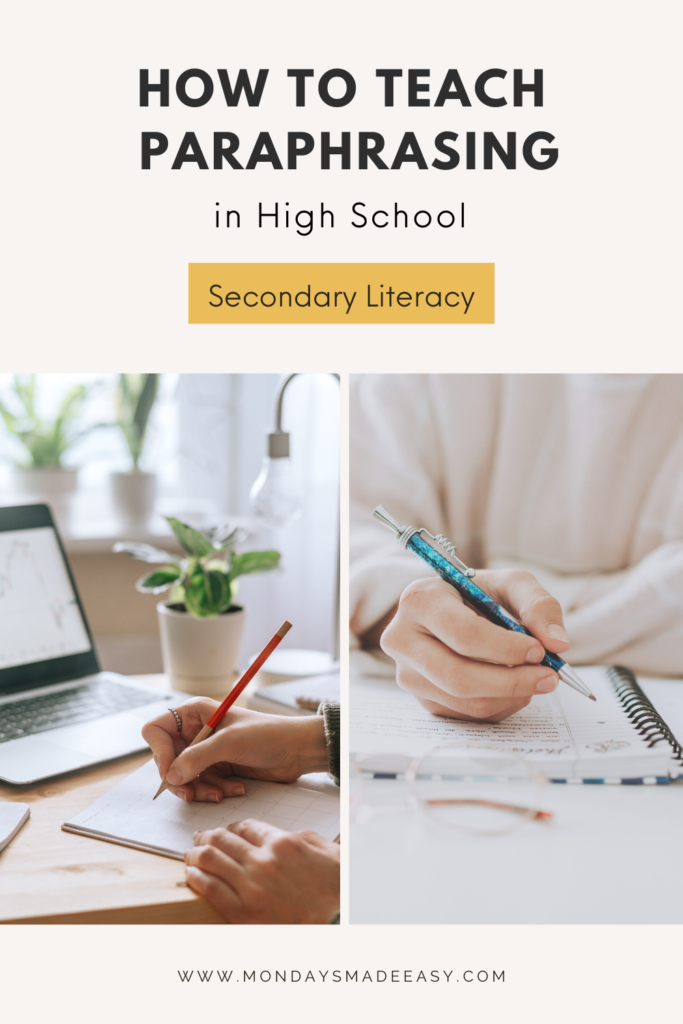
What is the Goal of Paraphrasing?
Put simply, the goal of paraphrasing is to use the student’s own words to rephrase the words of another source. When students use their own words, they demonstrate that they have interpreted the information, made sense of it, and reiterated it to their audience. Thus, the goal of paraphrasing is also to demonstrate the student’s understanding of the source .
Students can also use paraphrasing as a tool to deepen their own understanding of a text . This is especially useful for English Language Learners reading at a new Lexile level. It can also help students reading antiquated texts, like Shakespeare or Beowulf . Finding meaning within each sentence or phrase can act as a stepping stone to understanding challenging texts as a whole.
Finally, an important goal of paraphrasing is to help students avoid plagiarism . Students can avoid direct plagiarism by rewording their sources and reiterating their understanding. Additionally, they can avoid other forms of plagiarism by properly integrating citations into their writing .
What is the Difference Between Paraphrasing and Summarizing?
Knowing the difference between paraphrasing and summarizing is essential for students writing standardized tests , including the Ontario Secondary School Literacy Test (OSSLT) , the AP Language and Composition Exam, and both the SAT and the ACT.
Summarizing involves highlighting the main points of an entire work or idea. A summary includes some of the supporting details, but not all. The goal of a summary is to capture the “big picture. ” In contrast, paraphrasing involves reiterating isolated details within a work or idea . Paraphrasing restates the specific details within a work. It is not necessary to make a connection between these details and the “big picture” of a text.
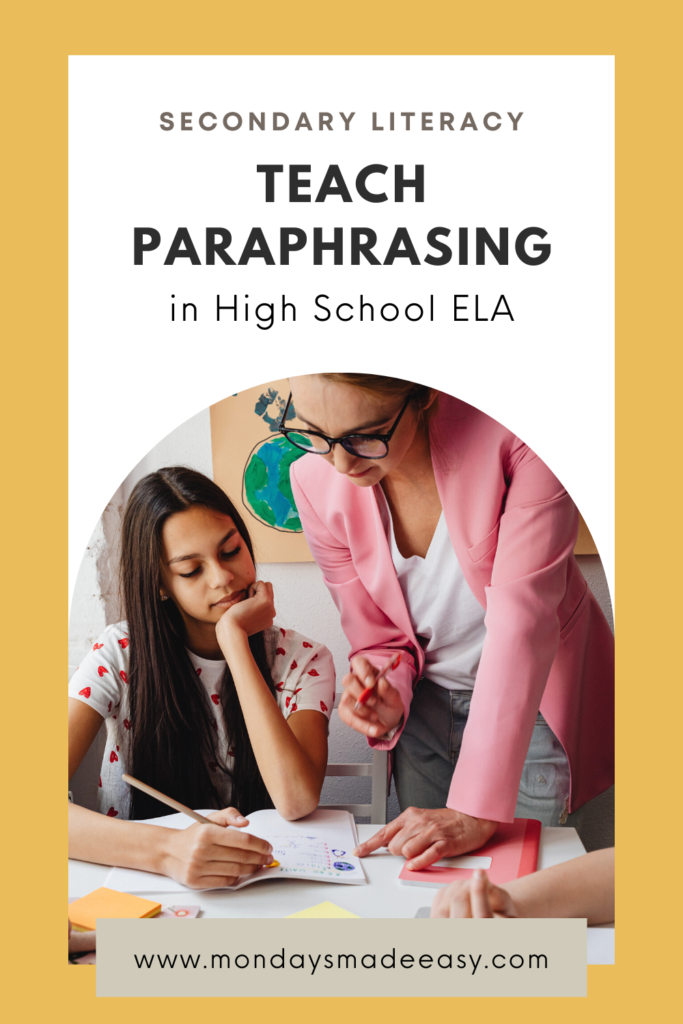
What is the Difference Between Paraphrasing and Annotating?
Paraphrasing and annotating share similarities. For one, both aim to explain a section of a work. Paraphrasing and annotating are also important parts of the close reading process. To differentiate between these two skills, it is best to consider paraphrasing as rewording the text, and annotating as reacting to the text . Deeper analysis, criticism, and opinion are important elements of annotation, but students should avoid including these elements when paraphrasing.
Activities to Teach Paraphrasing to High School Students
Use music to introduce paraphrasing to high school students.
Whether they realize it or not, students are using paraphrasing skills in their everyday life . When sharing information across cultural or generational boundaries, paraphrasing is often necessary. If you’ve ever needed to ask your students to translate modern music or slang, then you’ve essentially asked them to paraphrase! Similarly, if your students have asked you to decode a challenging sentence or paragraph within a text, they’ve also asked you to paraphrase.
A fun way to teach paraphrasing to high school students is to start in their comfort zone. I have had great success with using modern music to teach paraphrasing to older classes. This involves finding song lyrics that rely on slang words or cultural phrases and prompting students to paraphrase each line. Your students will get a kick out of explaining the meaning of these lyrics to you.
Here are some song suggestions for this activity. ( Note that some songs deal with mature themes. )
- “ 3 Nights ” by Dominic Fike
- “ Green Eyes ” by Arlo Parks
- “ Thinkin Bout You ” by Frank Ocean
- “ Sunflower ” by Harry Styles
- “ Don’t Start Now ” by Dua Lipa
With the right group of students, exploring the genre of rap can be a productive and engaging lesson for teaching paraphrasing . Unfortunately, rap music is not written for the classroom – even censored versions deal with mature subject matter. Use your professional judgment to determine whether or not this type of activity would be suitable for your students. The following song lyrics offer cultural dialect and a level of complexity that would be an engaging challenge to paraphrase:
- “ Humble ” by Kendrick Lamar ( censored version )
- “ Savage ” by Megan Thee Stallion ( censored version )
- “ God’s Plan ” by Drake ( censored version )
- “ Oceans ” by Jay Z
- “ The Season / Carry Me ” by Anderson .Paac
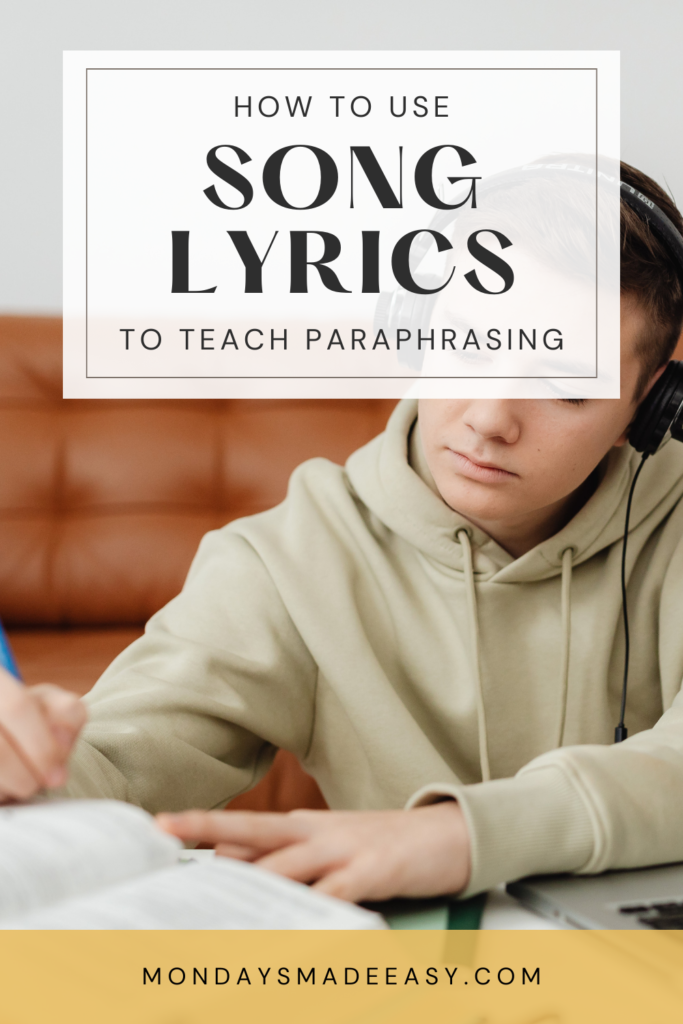
Apply Paraphrasing to More Challenging Texts
Now that students have practiced paraphrasing using high-interest texts , you can challenge them with literature outside of their comfort zone. Simply select an excerpt from a text written in Old English and format it on a worksheet with a blank text box next to the text. Students can paraphrase the text line-by-line to decipher meaning . This activity would pair well with any Shakespeare text in your school curriculum.
Alternatively, you could assign an antiquated text to explore as a class . Some options include The Seafarer , Jonathan Swift’s A Modest Proposal , or the epic poem Beowulf . I find this activity especially effective when I divide a text amongst groups of students and assign them the task of paraphrasing different sections.
Model Paraphrasing During Read-Alouds in High School
Teaching paraphrasing can be as simple as modeling it during a read-aloud period in your classroom. This can involve pausing after reading important parts of the text to reiterate the message. You can also practice paraphrasing aloud after reading complex sentences to offer clarification.
After teaching students about paraphrasing, you can also ask them to paraphrase for you during read-alouds. If you haven’t taught this skill yet, you can simply ask students a simpler prompt, like “In your own words, what is this sentence/paragraph communicating? ”
To differentiate between paraphrasing and annotating , you can ask students to keep their responses separate from their reactions to the text. When they begin to offer too much insight, analysis, or criticism, you can coach them to take a step back and focus simply on the meaning .
To differentiate between paraphrasing and summarizing, you can also prompt students to summarize the text after the read-aloud. If you haven’t taught the skill of summarizing yet, you can simply ask students another simple prompt like “ what is this text about? “
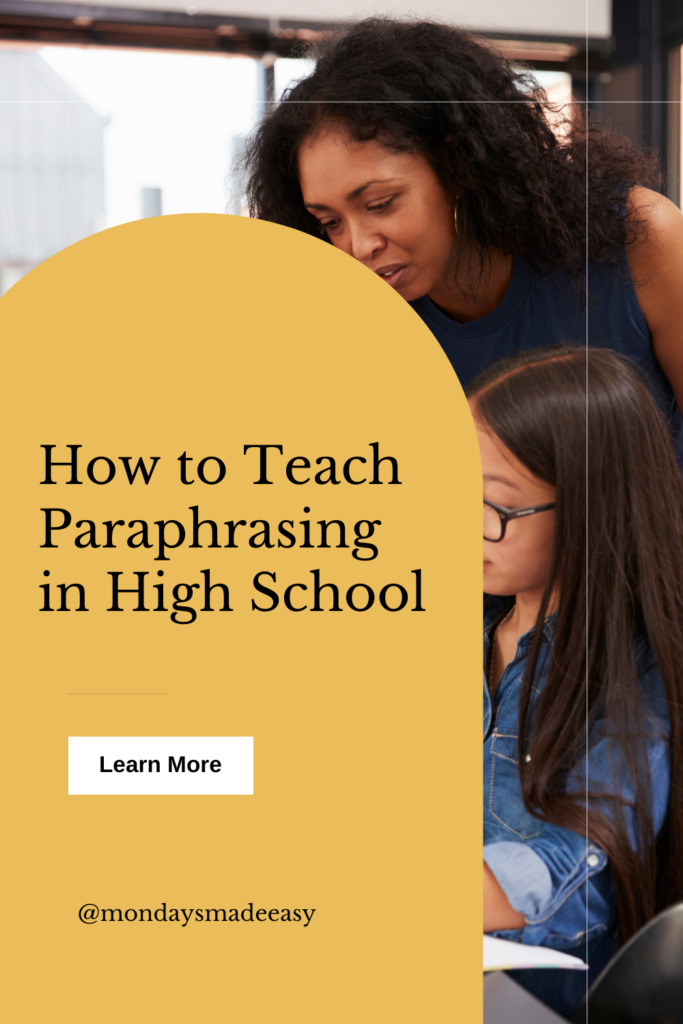
Practice Integrating In-Text Citations to Teach Paraphrasing to High School Students
As mentioned, one of the goals of paraphrasing is to help students avoid plagiarism in their writing. To do so, students must be able to properly integrate in-text citations . These two skills will help students to credit sources and maintain academic integrity.
I teach this skill explicitly to students by practicing in-text citations in class. Mondays Made Easy offers in-text citations practice worksheets to model how to write parenthetical and integrated citations in student writing. These worksheets explore high-interest topics and offer a number of differentiation options , including different Lexile levels and a Tic-Tac-Toe activity to implement student choice.
If you’ve been struggling to teach paraphrasing to high school students , I hope these lesson plans and ideas are able to offer you some engaging solutions. For more activities and advice for the English Language Arts classroom, be sure to follow along on Instagram:
mondaysmadeeasy
Canadian Curriculum Designer and Education Blogger

Reader Interactions
[…] in-text citations indicate where an idea originally came from. The idea could be word-for-word or paraphrased. As their name suggests, in-text citations exist within the text of an essay or paragraph. They […]
[…] You can incorporate classroom playlists into your English Language Arts curriculum in a number of ways. One way would be to simply have students select a song and write about the author’s purpose. Another way would be to assign students a playlist, have them select a song, and then have them paraphrase the music lyrics. […]
Exploring Plagiarism, Copyright, and Paraphrasing

- Resources & Preparation
- Instructional Plan
- Related Resources
This lesson helps students understand copyright, fair use, and plagiarism by focusing on why students should avoid plagiarism and exploring strategies that respect copyright and fair use. The lesson includes three parts, each framed by a KWL chart. In the first part, focusing on plagiarism, students discuss plagiarism and look at examples to determine whether the passages are plagiarized. Part two introduces copyright and fair use. Students use a Think-Pair-Share strategy to explore questions about fair use, then read several scenarios and determine if the uses described are fair use. In the third part, students develop paraphrasing skills through direct practice with paraphrasing text book passages using an online notetaking tool. This lesson plan was developed as part of a collaborative professional project with the American Library Association Office for Information Technology Policy and the American Association of School Librarians (AASL).
Featured Resources
- Checklist for Fair Use : Use this checklist to determine if your use of copyrighted material is considered fair use.
- ReadWriteThink Notetaker : Use this online tool to organize and reorganize notes.
From Theory to Practice
Students need multiple opportunities to practice citing sources and paraphrasing, to see examples of writing that properly uses paraphrasing and citations, and to reinforce these concepts. When students are taught information about these concepts early in their academic careers they are more likely to find success when the demands for research increase with the sophistication of their work. As their work becomes more sophisticated, students must have an understanding of fair use practices concerning copyright. Giving credit for a source is essential, but there are times when just a citation is not enough. Depending upon what part and how much of the text a writer uses, he or she may need to seek permission to use the material. By discussing and practicing paraphrasing and working through some fair use examples in this lesson, students should gain a better understanding of these concepts.
Further Reading
Common Core Standards
This resource has been aligned to the Common Core State Standards for states in which they have been adopted. If a state does not appear in the drop-down, CCSS alignments are forthcoming.
State Standards
This lesson has been aligned to standards in the following states. If a state does not appear in the drop-down, standard alignments are not currently available for that state.
NCTE/IRA National Standards for the English Language Arts
- 4. Students adjust their use of spoken, written, and visual language (e.g., conventions, style, vocabulary) to communicate effectively with a variety of audiences and for different purposes.
- 5. Students employ a wide range of strategies as they write and use different writing process elements appropriately to communicate with different audiences for a variety of purposes.
- 6. Students apply knowledge of language structure, language conventions (e.g., spelling and punctuation), media techniques, figurative language, and genre to create, critique, and discuss print and nonprint texts.
- 7. Students conduct research on issues and interests by generating ideas and questions, and by posing problems. They gather, evaluate, and synthesize data from a variety of sources (e.g., print and nonprint texts, artifacts, people) to communicate their discoveries in ways that suit their purpose and audience.
- 8. Students use a variety of technological and information resources (e.g., libraries, databases, computer networks, video) to gather and synthesize information and to create and communicate knowledge.
- 12. Students use spoken, written, and visual language to accomplish their own purposes (e.g., for learning, enjoyment, persuasion, and the exchange of information).
Materials and Technology
- Student textbook from a content area such as social studies or science
- Internet connection and projection capabilities
- Identifying Plagiarism PowerPoint Presentation
- Paraphrasing Practice PowerPoint Presentation
- Research Skills KWL
- Checklist for Fair Use
- Paraphrasing Practice handout
- Identifying Plagiarism examples
Preparation
- This lesson is designed to be co-planned and co-taught by the classroom teacher and the school library media specialist. Meet to decide responsibilities for teaching the lessons and assessing student work, as well as to arrange logistics for using the library media center. In advance, agree upon lead and support educator roles for each session. Educators are strongly encouraged to alternate roles depending upon individual strengths and expertise.
- Ideally, the library media specialist and English language arts teacher will also collaborate with a willing colleague from the science or social science department for the activities in this lesson.
- Choose a section or chapter in the student textbook to use during each part of the lesson and as part of the student assessment. Textbook sections that have not/may not be covered in class work best.
- Make copies of the Research Skills KWL handout and Checklist for Fair Use for each student.
- Make arrangements to project the Paraphrasing Practice PowerPoint Presentation and the Identifying Plagiarism PowerPoint Presentation , or create separate transparencies for each sentence on the Paraphrasing Practice and Identifying Plagiarism sheets.
- If students need additional practice, choose passages from available texts (e.g., an elementary level encyclopedia; student writing; unfamiliar school or college textbooks). Work together to create your own paraphrased and plagiarized versions of the passages to extend student options for identifying plagiarism.
- The classroom teacher and library media specialist should test the ReadWriteThink Notetaker on the computers to familiarize themselves with the tool and to ensure the Flash plug-in is installed. Schools can download the plug-in from the Technical Support page .
Student Objectives
Students will:
- define plagiarism, fair use, and paraphrasing.
- recognize and provide examples of plagiarism, fair use, and paraphrasing.
- use appropriate paraphrasing strategies to replace advanced-level words with age/grade/level appropriate vocabulary.
Note: In addition to the stated NCTE/IRA standards, this lesson is also aligned to the following American Association of School Librarians Standards for the 21st-Century Learner .
- Respect copyright/intellectual property rights of creators and producers.
- Follow ethical and legal guidelines in gathering and using information
- Use information and technology ethically and responsibly.
- Respect the principles of intellectual freedom.
Session One
- Distribute the Research Skills KWL handout, and ask the students to complete the "know" and "want to know" columns for each of the three items.
- The classroom teacher and library media specialist should co-lead a discussion of the students' responses for the "know" and "want to know" columns of the plagiarism section of the worksheet.
- Create a class definition of plagiarism, using the information on students KWL chart. Be sure that the class definition includes the idea of using another person's words or ideas without crediting the original writer.
- Failure of the assignment or course
- Requirement to do the work over
- Suspension/expulsion
- Lawsuit, fines, and/or firing for workplace plagiarism
- Paraphrase with appropriate citations
- Give credit through footnotes/endnotes, a works cited page, or a bibliography
- Share examples from the Identifying Plagiarism PowerPoint Presentation or Identifying Plagiarism Sheet , and ask students to determine whether the passages are plagiarized. Add examples from class texts to expand this practice at identifying plagiarism.
- During the class discussion of the passages, consider the following advice from Laura Hennessey DeSena's book Preventing Plagiarism: Tips and Techniques : "In teaching students how to paraphrase, I tell them to put the text aside for a few moments and try to remember what the writer said--the ideas, the insights. Then I ask students to try to write down these ideas. I have them compare the two versions, their translation with the original text. Integrity of ideas much remain intact. If student writers change the meaning, then they will have to try again. If they, unintentionally, appropriated exact language, then they will have to try again. If students are unable to remember what they have read, then they should view the passage as a whole and synthesize the main points in their own words. Encourage them to change sentence structure, in addition to altering diction. In changing language choices, they should try to use their own words, before consulting a dictionary or thesaurus." (49). DeSena, Laura Hennessey. 2007. Preventing Plagiarism: Tips and Techniques . (Chapter 3). Urbana, IL: NCTE.
Have students complete the "learned" column for plagiarism on the Research Skills KWL handout.
If time permits, share this school media center Website on plagiarism to review the concepts that have been covered and point out available resources.
Session Two
- Begin with a brief review of the previous session.
- Discuss the students' responses for the "know" and "want to know" columns of the fair use section of the Research Skills KWL handout.
- The Copyright Office at the Library of Congress defines fair use as "purposes for which the reproduction of a particular work may be considered ‘fair,' such as criticism, comment, news reporting, teaching, scholarship, and research."
- The 1961 Report of the Register of Copyrights on the General Revision of the U.S. Copyright Law cites examples of activities that courts have regarded as fair use: "quotation of excerpts in a review or criticism for purposes of illustration or comment; quotation of short passages in a scholarly or technical work, for illustration or clarification of the author's observations; use in a parody of some of the content of the work parodied; summary of an address or article, with brief quotations, in a news report; reproduction by a library of a portion of a work to replace part of a damaged copy; reproduction by a teacher or student of a small part of a work to illustrate a lesson; reproduction of a work in legislative or judicial proceedings or reports; incidental and fortuitous reproduction, in a newsreel or broadcast, of a work located in the scene of an event being reported." ( Factsheet on fair use of copyrighted works . U.S. Copyright Office, July 2006.)
- Using the information from Copyright Kids! Copyright Basics & FAQs , share each question with students and have them use the Think-Pair-Share strategy (think about it on your own, pair with a neighbor, share with a larger group) to answer the question.
- When students have had a chance to consider all the questions, reveal the answers from the Website .
- in school: for assignments such as term papers, class plays, presentations
- personal life: Internet downloads, podcasts, personal writings
- To expand the discussion to include music downloads, show the class the first two and a half minutes of the Ball State University Libraries video "What Do You Think about Intellectual Property?" from their Copyright for Students page.
- Have students discuss their thoughts and reactions.
- Distribute and review the Checklist for Fair Use handout.
- John is writing a science term paper on the life of a ferret. He has used two books, a general encyclopedia, and several Websites to gather his information. He has put much of the information into his own words but has used a few direct quotes, citing information that is not his own. Is his work okay according to the Checklist for Fair Use ? Why or why not? (Answer: yes—educational purposes; only a portion of information used; factual information; paraphrased; and credit given.)
- Mary and her friends like the poems of Shel Silverstein, so she copied a bunch of the poems using the school photocopier, stapled them together, and made plans to sell the booklet to anyone who wants it. Is this fair use? Why or why not? (Answer: no—the poems being reproduced are not the student's own work; entire poems used; heart of the work used; creative work; copies sold, therefore depriving author of income.)
- Uncle Marty always videotapes family events. He has put together a video CD with some of the highlights and is giving out the CDs to family members. He has asked each recipient to pay him for the cost of the blank CD so he can continue to make more copies. Is this fair use? Why or why not? (Answer: yes—originator doing the reproduction.)
- Taylor has purchased music from iTunes and placed it on her MP3 player. She also gave the music to three of her friends. Are these uses fair? Why or why not? (Answer: yes and no—The download to Taylor's MP3 player is fine because she paid for the download; however, giving the music to her friends is not because it deprives the copyright owner of income.)
- Allow time for follow-up discussion. Include in the discussion when and how to seek permission to use a copyrighted work (see the U.S. Copyright Office answers to Frequently Asked Questions about Copyright ).
- Have the students complete the "learned" column of the fair use section of the Research Skills KWL handout.
Session Three
- Begin with a review of the previous sessions.
- Discuss students' responses for the "know" and "want to know" columns of the paraphrasing section of the Research Skills KWL handout.
- Create a class definition of paraphrasing, using the information on students KWL chart. Be sure that the class definition includes the idea of restating another person's ideas in your own words or format.
- Ask students to give examples of some of the ways they paraphrase information. Make sure the discussion includes summarizing, rewording, and using direct quotes.
- Make sure that students understand that summarizing is putting the main ideas of a piece of writing in a shortened form that uses their own words. This process can be completed by reading an entire text (paragraph, page, section, etc.) and then writing down what they remember accurately.
- In collaboration with another content area teacher, assign an unfamiliar passage from the students' textbook for students to read and summarize.
- For additional practice, introduce students to the ReadWriteThink Notetaker . Allow time for them to become familiar with the tool, perhaps having them practice together using the passage assigned in the previous step.
- Assign a new passage from the unfamiliar section, and ask the students to use the ReadWriteThink Notetaker to summarize the information.
- Make sure students understand that rewording is restating the material in their own words. Explain to students that their teachers expect them to write as students would write, not as textbooks or encyclopedias sound. Then show them how to take a statement and rewrite it using words they know and would use.
- Do one or two of the examples in the Paraphrasing Practice Powerpoint Presentation together, deciding which words should be changed and which can stay.
- Complete the remainder one at a time using Think-Pair-Share or some other small group strategy.
- Go over the students' suggestions aloud after each example, and offer comments on the results.
- An important person's words lend credibility to the writing.
- The reader will think you are very strategic to seek out an authority's idea to include in the report.
- The words and phrases in the quote simply express the idea too powerfully not to use the original.
- Ask students to consider why it is important that a paper is not one long quote or a series of quotes from a book even if credit is given.
- Provide instruction on footnotes, endnotes, or bibliography compilation if appropriate at this time, using the class textbook.
- Have students complete the "learned" portion of the Research Skills KWL handout for paraphrasing.
- Have volunteers share what they learned over the entire lesson.
Student Assessment / Reflections
- The classroom teacher and school media specialist should assess students’ learning through observation and anecdotal notetaking on participation and class discussions.
- Test students’ understanding by choosing a three-paragraph passage from the class textbook, and asking each student to demonstrate the following skills: summarize paragraph one; paraphrase paragraph two; and choose a significant quotation from paragraph three, citing it correctly.
- Calendar Activities
- Professional Library
- Student Interactives
- Lesson Plans
This document is a code of best practices that helps educators using media literacy concepts and techniques to interpret the copyright doctrine of fair use.
Useful for a wide variety of reading and writing activities, this outlining tool allows students to organize up to five levels of information.
This tool allows students to create an online K-W-L chart. Saving capability makes it easy for them to start the chart before reading and then return to it to reflect on what they learned.
- Print this resource
Explore Resources by Grade
- Kindergarten K
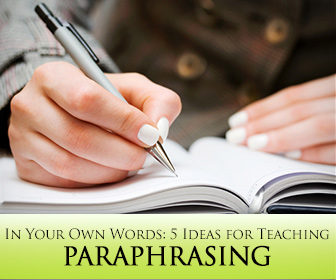
- All topics A-Z
- Grammar
- Vocabulary
- Speaking
- Reading
- Listening
- Writing
- Pronunciation
- Virtual Classroom
- Worksheets by season
- 600 Creative Writing Prompts
- Warmers, fillers & ice-breakers
- Coloring pages to print
- Flashcards
- Classroom management worksheets
- Emergency worksheets
- Revision worksheets
- Resources we recommend
- Copyright 2007-2021 пїЅ
- Submit a worksheet
- Mobile version
Paraphrasing Lesson Plan: Research to Build and Present Knowledge
*Click to open and customize your own copy of the Paraphrasing Lesson Plan .
This lesson accompanies the BrainPOP topic Paraphrasing , and supports the standard of paraphrasing information in notes and finished work. Students demonstrate understanding through a variety of projects.
Step 1: ACTIVATE PRIOR KNOWLEDGE
Display a few sentences from an article, such as this:
“One of the first companies to make non-toxic crayons safe for toddlers, Crayola was an instant success. According to the company’s website, Crayola produced more than 100 billion crayons in its first 100 years, and it continues to produce an astounding 3 billion each year!”
Ask students:
- How would you paraphrase this, or say it in your own words?
- Why might you paraphrase something you’ve read?
Step 2: BUILD KNOWLEDGE
- Read the description on the Paraphrasing topic page .
- Play the Movie , pausing to check for understanding.
- Have students read one of the following Related Reading articles: “Way Back When,” “Arts and Entertainment,” or “Language.” Partner them with someone who read a different article to share what they learned with each other.
Step 3: APPLY and ASSESS
Students take the Paraphrasing Quiz , applying essential literacy skills while demonstrating what they learned about this topic.
Step 4: DEEPEN and EXTEND
Students express what they learned about paraphrasing while practicing essential literacy skills with one or more of the following activities. Differentiate by assigning ones that meet individual student needs.
- Make-a-Movie : Produce a preview for a movie about an article you’ve read that paraphrases its key ideas.
- Make-a-Map : Make a concept map identifying strategies for paraphrasing a page in a textbook. Use specific examples.
- Creative Coding : Code a conversation where one character speaks and the other paraphrases what they say.
More to Explore
Related BrainPOP Topics : Deepen understanding of research and writing strategies with these topics: Plagiarism , Citing Sources , and Research .
Teacher Support Resources:
- Pause Point Overview : Video tutorial showing how Pause Points actively engage students to stop, think, and express ideas.
- Learning Activities Modifications : Strategies to meet ELL and other instructional and student needs.
- Learning Activities Support : Resources for best practices using BrainPOP.
Lesson Plan Common Core State Standards Alignments

- BrainPOP Jr. (K-3)
- BrainPOP ELL
- BrainPOP Science
- BrainPOP Español
- BrainPOP Français
- Set Up Accounts
- Single Sign-on
- Manage Subscription
- Quick Tours
- About BrainPOP

- Terms of Use
- Privacy Policy
- Trademarks & Copyrights

Paraphrasing
In our Paraphrasing lesson plan, students learn what paraphrasing is, when it is used, and strategies for paraphrasing effectively. Students also learn how to distinguish paraphrasing from summarizing and plagiarism.
Description
Additional information.
Our Paraphrasing lesson plan introduces students to paraphrasing selections of text correctly. The students will also learn the difference between summarizing and paraphrasing. In addition, plagiarism is discussed and reasons are given why it’s wrong to plagiarize another person’s work. Students are asked to work collaboratively to summarize a given piece of text. Students are also asked to paraphrase several sentences and short paragraphs on their own in order to demonstrate their understanding of the concept.
At the end of the lesson, students will be able to define paraphrase, distinguish it from summarizing and plagiarism, and correctly paraphrase selected text and passages.
Thank you for submitting a review!
Your input is very much appreciated. Share it with your friends so they can enjoy it too!
I am very impressed with this curriculum.
I used this for 5th grade homeschool. It was very helpful in teaching how to use alternative phrases. She struggles with writing narratives. The curriculum is written for classroom use but I am able to use most of the assignments as homework. The list of resources for each subject is amazing.
Main Idea lesson plan
Excellent Resource! Saved me lots of time!
Quality all the way..
So happy to have come across this resource. The plans are detailed and thorough. Resources are excellent. However, some of the resource links need to be updated as they no longer exist or link is broken.
Related products
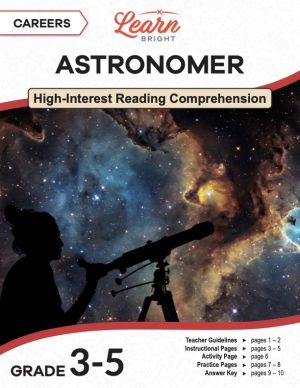
Careers: Astronomer
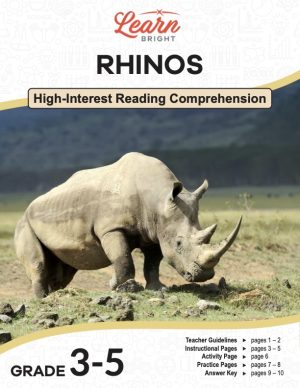
Man o’ Wars

Make Your Life Easier With Our Lesson Plans
Stay up-to-date with new lessons.

- Lesson Plans
- For Teachers
© 2024 Learn Bright. All rights reserved. Terms and Conditions. Privacy Policy.
- Sign Up for Free
Distinguishing Paraphrasing from Patchwriting
Lesson plan, grade levels.
10–12 or first-year college writing
Students will learn how to distinguish paraphrasing from “patchwriting”—that is, copying language from their sources and making small changes.
Total Estimated Class Time
45–70 minutes
Additional Outcome
Students will recognize that to effectively paraphrase from their source material they must comprehend what they have read.
Course Work or Assignment Underway
Students are conducting research and making notes of what they might use as sources in their own writing.
Work Completed before Class
Previous classes will have introduced students to types of writing that require them to quote or paraphrase from sources and what incorporating sources adds to their texts. Students may have read the appropriate excerpt (by Simon Sinek for high school classes or by Doris Lessing for college classes) before class.
Students should have access to Kahoot.it on a portable device, such as a laptop, tablet, or cell phone, or to a response clicker. If not, the presenter should hand out four note cards labeled 1–4 to all students.
Sequence of Classroom Activities
- Begin the PowerPoint presentation Reading and Writing with Sources . Use the high school or college presentation as appropriate. Explain the learning objective for today’s lesson (paraphrasing correctly), as well as the two topics (quoting and paraphrasing) that will be covered.
- Give students a few minutes to read over the paragraph (Sinek, slide 3 in the high school presentation, or Lessing, slide 4 in the college presentation) on the screen. While students are reading, pass out lined paper.
- Next, ask students to paraphrase what they read. Give students about five minutes to complete this task. As students are paraphrasing, observe which students are looking back at the screen frequently as they paraphrase.
- When students have finished, ask for a few volunteers to share what they wrote. After a few students share, explain how you noticed many of them looking back at the source as they paraphrased. Then explain how this habit suggests that they are likely to be accidentally patchwriting or plagiarizing. You can inform students that they will learn more about how to avoid this problem in today’s presentation.
- For the high school presentation, pass out copies of the Simon Sinek paragraph from slide 3 so that students can refer to it throughout the presentation.
- If using Kahoot , before continuing with the presentation, have students log onto their devices and go to Kahoot.it . Give them the game PIN. Explain that they will be answering questions throughout the presentation. While students participate in the presentation, their responses will be anonymous, so the presenter should assign each student a random number or other nonidentifying username as their Kahoot.it nickname. If not using Kahoot or clickers, pass out note cards labeled 1–4.
- Then begin the presentation. The presentation focuses on quoting and paraphrasing. Since most students have had more experience with quoting than paraphrasing, take a few minutes to define (or ask students to define) how one paraphrases. Follow the PowerPoint speaker notes for guidance.
- Before asking students to respond to example citations, explain to them the four possible responses, as noted in the PowerPoint (slide 6 in the high school presentation, slide 5 in the college presentation). These points will need to be explained several times throughout the presentation:
- The sample is accurate and ethical.
- There is not enough credit for language .
- There is not enough credit for ideas .
- The source is misrepresented.
- Read aloud each example that cites the original text. Discuss why the sample quotations and paraphrases are incorrect. It might be helpful to ask students who answered correctly to explain why they answered that way to get a conversation started about how to correct the sample quotation.
- After completing the section on quotations, present the punctuation slides (slides 11–12 from the high school presentation, slides 10–13 from the college presentation), which review when and how to use quotation marks, in-text citations, and brackets. It might be helpful to offer students an example of how brackets are used as provided in the speaker notes. These slides also present the opportunity to discuss the two distinct tools for in-text citation: quotation marks for showing use of language and parenthetical information for showing the use of ideas.
- Next have students respond to sample paraphrases as they did with the quotations. The presentation refers to “patchwriting.” The presenter should spend a few moments defining patchwriting as a way of misusing sources in which someone copies the original language but changes every few words or uses synonyms. Patchwriting is not paraphrasing. A paraphrase uses one’s own words to capture an idea. This moment in the presentation is critical because most patchwriting occurs unintentionally and often results when a student does not understand how to paraphrase and does not fully comprehend a text.
- Slides 23–24 in both presentations are meant to provide an example of patchwriting. It should be noted to students that it is OK if they do not fully understand the sample text. When students paraphrase challenging texts, patchwriting is more likely to occur. Slide 24 demonstrates how many words from the original text are similar to the sample. The slide provides a visual representation of patchwriting.
- The last few slides reiterate the difference between patchwriting and paraphrasing. Slide 25 in the high school presentation and slide 29 in the college presentation describe patchwriting as editing rather than representing ideas in one’s own words.
- To conclude the presentation, discuss the slides (28 in the high school presentation and 30 in the college presentation) that provide tips for improving paraphrase and summary skills. It might be helpful for the presenter to add ideas and strategies that directly coincide with projects and types of writing students will be completing. When reviewing the consequences of plagiarism, the presenter might add the consequences for academic honesty at the presenter’s institution, since the examples on the slide are generalized. Note to students that the consequences are highlighted not to scare them but to make them aware that paraphrasing is an important aspect of writing that needs attention and practice.

Alternative Approaches
A lesson on how to properly include quotations and citations in specific writing formats may be done before or after this lesson.
When students have completed this workshop, they can complete the group activity outlined below to practice the skills introduced to them.
Before or after this lesson, students may complete hands-on activities in which they must evaluate the quotations and paraphrases in anonymous student writing samples and explain how to correct them.
Lesson Materials
SmartBoard or projector
Lined paper
Reading and Writing with Sources (college or high school)
Kahoot.it , portable devices for students, and student response clickers, or—if not using Kahoot— note cards labeled 1–4 for students to respond to the presentation’s questions
Group activity
Bethany Macko 29 April 2020 AT 08:04 PM
Thank you for this engaging lesson idea. Can you share the PIN for kahoot.it? I don't see it in the post. Thank you!
Your e-mail address will not be published
Morgan 30 April 2020 AT 10:04 AM
Hi. Thanks for your question. If you use the following link, you can play the Kahoot as a guest or sign in to your existing Kahoot account and play it from there.
https://create.kahoot.it/share/high-school-rwws/3bc1e144-e05b-4de8-9e26-212ce88ddbd4
Melony 02 May 2020 AT 07:05 AM
Solid ideas!! Like working in a Kahoot for this lesson as I teach them how to research an author’s life as it relates to his/her poetry.
Join the Conversation
We invite you to comment on this post and exchange ideas with other site visitors. Comments are moderated and subject to terms of service.
If you have a question for the MLA's editors, submit it to Ask the MLA!
paraphrasing for high school
All Formats
Resource types, all resource types.
- Rating Count
- Price (Ascending)
- Price (Descending)
- Most Recent
Paraphrasing for high school
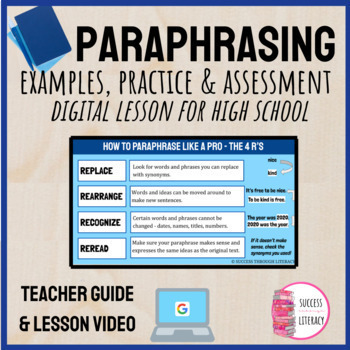
Paraphrasing Lesson & Activity for High School Writing Skills

- Google Drive™ folder

Middle- High School Paraphrasing and Citation Activity, Writing and Research

- Word Document File
- Internet Activities
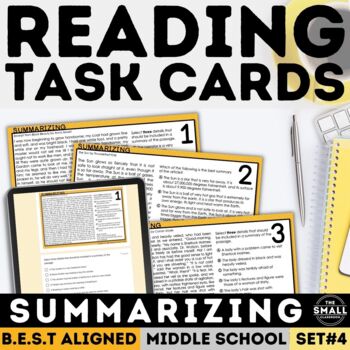
Summarizing & Paraphrasing Task Cards Practice Worksheets Passages & Questions

- Google Apps™
- Easel Activity
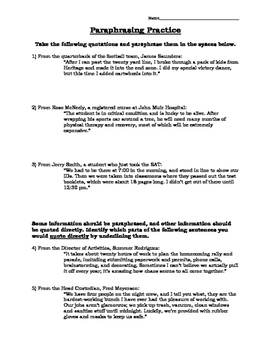
High School Journalism Lesson: Paraphrasing Quotations

Middle- High School Paraphrasing Activity- JUST SAY NO TO COPY AND PASTE!!
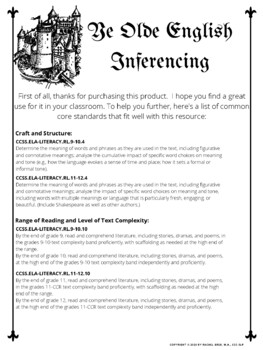
High School Inferencing and Paraphrasing : Ye Olde English Inferencing

How to Write a Research Paper for Beginners Unit - MLA - Middle and High School

Paraphrasing , Quoting, & Summarizing: Informative Writing Skills PRINT + DIGITAL
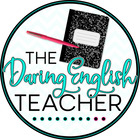
Avoiding Plagiarism Paraphrasing Activity with Movie Quotes

Research Skills Stations (MLA) paraphrase , embed & cite quotes, works cited

How to Write a Research Paper for Beginners APA & MLA Bundle - Middle & High
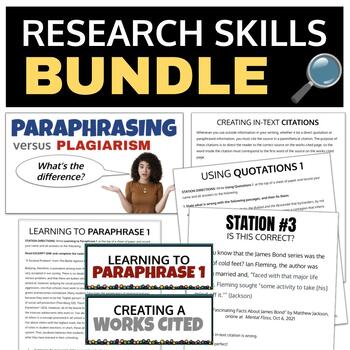
Research Skills Bundle (MLA) paraphrase , embed & cite quotes, works cited
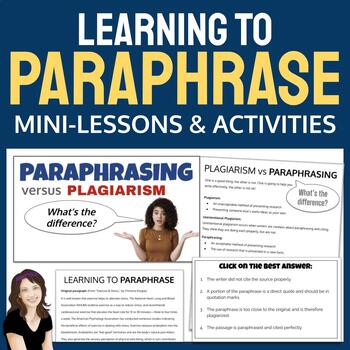
Paraphrasing Lesson, Activities, and Practice

Ramen Noodle Summarizing and Cow Cud Paraphrasing | Nonfiction Text

How to Write a Research Paper for Beginners Unit - APA - Middle and High School
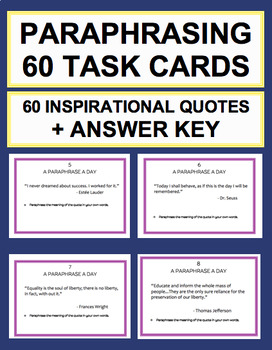
Paraphrasing Practice Task Cards

Research Skills: Paraphrasing and Practice Worksheet

Paraphrasing vs. Plagiarism

Paraphrasing Practice Worksheets

Research Magazine with lessons on paraphrasing and using quotations

Writing a Research Paper Complete Unit - High School - Outline - Project -Speech
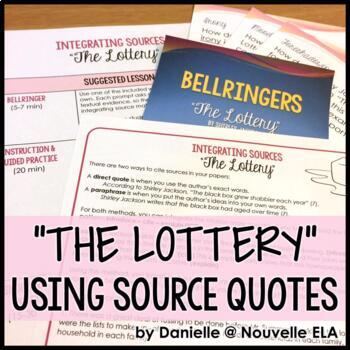
The Lottery Activities - Using Quotes and Paraphrase in Literary Analysis
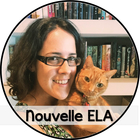
Writing & Research Comprehensive Lesson Bundle - Paraphrase , Citations & More

Movie Quote Paraphrasing Bundle
- We're hiring
- Help & FAQ
- Privacy policy
- Student privacy
- Terms of service
- Tell us what you think
- Our Mission
Unlocking Engagement in Middle and High School Math
A small shift in lesson presentation can encourage older students to actively participate in class.

The usual classroom symphony of settling students, chattering friends, and whispered gossip was abruptly interrupted by groans and jeers when they saw another dull math warm-up. As a new seventh-grade math teacher, I yearned to make the lessons engaging, but I felt constrained by the curriculum and struggled to stay ahead of the students, often learning the material the night before I taught it. In my focus on mastering the content, I had neglected the student experience, which, as their growing disengagement and defiance made clear, was lacking.
One day, amid the usual classroom hubbub, a sense of resignation hung heavy in the air. Students went through the motions of learning, some with glazed eyes copying notes verbatim, while others chatted animatedly about weekend plans. In stark contrast, “Sofia,” usually a beacon of participation, slumped in her chair, and “Josiah,” who often fidgeted, leaned forward intently, gesturing toward a crucial note on the whiteboard.
The usual mix of focused energy and playful banter felt off-balance, replaced by a quiet apathy. It felt like a repetitive performance, and I knew I had to offer them something more meaningful. I also knew that many of them genuinely wanted to learn, but the classroom disarray forced them into survival mode, simply hoping to avoid embarrassment or disruption.
My train of thought was interrupted by a knock at the door, barely audible over the din of student protest. My math coach entered with a smile, but my initial flicker of hope was quickly extinguished by the self-doubt gnawing at me, questioning my career choice.
A Surprising Discovery
With gentle encouragement from my coach, I launched into the lesson, my nerves on edge from a potent mix of disengaged students, my own lack of confidence, and the looming presence of an external observer. My coach had mentioned that many students indicated a desire to learn, and I held on to that thought as I wrote the first step on the board. Whether due to nerves or to sleep deprivation, I found myself pausing after each step, struggling to recall what came next. During these pauses, I noticed my students surprisingly engaged, gesturing and discussing what might happen next.
After a few instances of this, my coach pulled me aside and suggested I continue pausing and ask the students to predict the next step. The transformation was gradual at first, but it quickly spread throughout the room. Once-rowdy students were eagerly waiting, anticipating the next step. The rest of the lesson unfolded completely differently. I no longer felt burdened by the content, and the students thrived on unraveling the mystery.
Inspired by this experience, my coach and I sought to refine this concept of student engagement. I decided to use existing examples from the curriculum, sequencing them and displaying each step on a slide with animation. Students would then predict the next step. My coach expressed concern about the potential loss of momentum if no one could guess correctly. I countered with the idea of presenting two steps, like step one and step two, and asking students to compare them. We were both excited, and I eagerly began crafting the initial iterations of what I called the spark sequence .
This simple yet impactful pedagogical strategy is designed to enhance student learning and engagement while reducing teacher workload. It leverages our natural pattern recognition abilities to do the following:
- Focus student attention on key details through a step-by-step process
- Develop critical thinking by comparing similarities and differences across each step
- Boost confidence by enabling students to share their observations and build upon their understanding
New Levels of Engagement
The next day, a mix of excitement and nervousness coursed through me as I began the lesson. The usual pre-lesson grumbling commenced, but as we reached the first example, a shift was palpable. I wasn’t burdened with the explanation, and the students were once again engaged by the challenge. With two steps presented, they could freely analyze and compare. I then employed the “same-different” strategy, where students compare two things and identify similarities and differences.
While it took some students a moment to grasp the concept, the classroom chatter had transformed. Students were actively discussing their observations, their faces lighting up with understanding as the lesson progressed. A chorus of “That was fun!” confirmed their enjoyment, and they walked away from the example knowing how to solve it.
I then revisited the complete example, but instead of lecturing, I had students take turns explaining each step, collaboratively constructing a narrative.
Steps in the spark sequence
- Briefly display each step with minimal distractions.
- Think-pair-share. After each step, ask students to silently identify what’s the same and different (<10 seconds). Then, have them share their observations with a partner (15 seconds each).
- Repeat steps two and three.
- Once the sequence is complete, reveal the final outcome or justification. Allow students time to recall (10–30 seconds), then have them discuss with their partners (<1 minute).
- Wrap up: The whole class shares out. The teacher clears up any remaining misconceptions and summarizes the day’s learning.
In the end, I learned more from the students’ explanations than I had from the countless hours spent preparing the night before. In essence, I had discovered a way to engage my students, reduce my prep time, and learn alongside them. They became active participants in their education, taking the driver’s seat in their learning journey. By stepping aside and letting them take ownership, I fostered engagement and a shared learning experience for all of us.
Looking back, these moments marked a turning point. They transformed my doubts about my career choice into a deep sense of purpose. My students continue to love this strategy and the framework for discussion it provides. We’ve even incorporated it into student work, as they strive to create their own sequences or explore different applications of the strategy. It’s a place where we’ve all thrived—an oasis of learning and mutual respect, and a space where this old student has learned from his younger ones.
More From Forbes
Four leadership lessons from the ncaa men’s final four.
- Share to Facebook
- Share to Twitter
- Share to Linkedin
DALLAS, TEXAS - MARCH 31: DJ Burns Jr. #30 and Michael O'Connell #12 of the North Carolina State ... [+] Wolfpack chest bump after a foul in the Elite 8 round of the NCAA Men's Basketball Tournament against the Duke Blue Devils at American Airlines Center on March 31, 2024 in Dallas, Texas. (Photo by Carmen Mandato)
The student bodies at four universities—Purdue, NC State, Alabama and UCONN—won’t have gotten much sleep these past couple of weeks, what with all the NCAA basketball their teams have been playing and winning. And seats may be empty in many a classroom on those campuses this week. But school is definitely open for those looking to learn leadership from what has been an amazing college basketball tournament.
Where to begin? Well, we have our Final Four teams in each of the above-mentioned universities, and the way each one punched its ticket to Glendale, Arizona offers a teaching moment. So, sharpen those pencils, silence those phones, and let’s begin with Purdue, the subject of a recent lecture in this classroom about the importance of communication between leaders and their teams.
Lesson #1: Sometimes, you have to sit in it…
After bowing out in the first round of the 2023 tournament to Farleigh Dickinson, Purdue has lived up to its high national ranking and high tournament seeding this year and earned its place in the Final Four. How have they put last year’s dramatic failure in the rearview mirror? “We had to sit in it. We had to take it,” explained Purdue Head Coach Matt Painter after his Boilermakers dispatched Tennessee in a hard-fought 72-66 win. “Sometimes when you sit in it, and you’re honest with yourselves and you take it, some great things can happen.”
One of those great things involved, once again, communication. After seeing his team fall behind 32-21 on the hot hand of Tennessee’s Dalton Knecht, Painter called a timeout to rally the troops and find a way to stop Knecht. Painter solved the technical problem by assigning a bigger, more physical defender to guard Knecht, but once again, it was a player who led the rallying cry when towering center Zach Edey shouted to his teammates, “We’re not tired! They’re tired! Let’s Go!”
And just to show how good-to-go he was, Edey clocked in with 40 points and 16 rebounds playing all but 33 seconds of the game.
Lesson #2: Hidden hard work pays off
Total Solar Eclipse Emoji Map Meme Tells You All You Need To Know
The top 10 richest people in the world april 2024, the walking dead the ones who live season finale review super easy barely an inconvenience.
Meanwhile, the Alabama Crimson Tide defeated the Clemson Tigers 89-82 behind the three-point shooting of guard Mark Sears who has, in my opinion, been the best player of the tournament so far.
Boy, does he make those threes look easy, eh?
What most people don’t know is that today’s three-point prowess wasn’t a God-given gift to him. In his freshman season, his three-point shooting percentage was 28 percent, which was certainly below par for a smallish guard. So, what did Sears do to correct an obvious and important flaw in his skill set? He committed that he would make 15,000 three-point shots over the following summer. Not shoot them, make them . To do that, he had to take about 50,000 shots, which translated to 1,000 three-point shots every day, with nary a camera in site to record all his hard work.
Where’s the glory in that?
The glory came when the lights came on, the crowds poured in and his team needed him most these last two weeks. The year following his summer of raining threes, he shot 40 percent from outside the arc. And this year, he has shot 43.5 percent, which is 15 points higher than his freshman year. Against Clemson, he drilled seven three-pointers. That’s when the greatness that he demonstrated when nobody was looking was vindicated by the greatness he displayed when everybody was looking.
“Hard work wins,” he said matter-of-factly postgame. (This will be on the exam.)
BOSTON, MASSACHUSETTS - MARCH 30: Head coach Dan Hurley of the Connecticut Huskies reacts against ... [+] the Illinois Fighting Illini during the first half in the Elite 8 round of the NCAA Men's Basketball Tournament at TD Garden on March 30, 2024 in Boston, Massachusetts. (Photo by Michael Reaves)
Lesson #3: Defy human nature
Former Villanova Coach Jay Wright described what UCONN will fight this week. “Their biggest opponent this week will be human nature,” Wright said of the defending national champions who have led every game they’ve played in this tournament by at least 30 points. “All week long, they’ll be reminded how amazing they are, how great a favorite they are. They have to avoid complacency, defy that nature, and stay hungry.”
Intensity shouldn’t be a problem with these Huskies. If one of the leader’s key roles is to model a winning mindset, the Huskies couldn’t ask for a better, which is to say, more intense leader than Coach Dan Hurley.
“They're not going to get some guy that's going to rest on his laurels after winning one. Who’s just going to go and ring the bell at the stock exchange and go hang out with [President Joe] Biden, and then he’s going to take a year off and do the honeymoon [things],” noted Hurley after his team blowtorched No. 3 seed Illinois in the second half to win 77-52.
“I'm an obsessed coach, and I'm going to be more of a maniac the next couple of days than I was leading up to this. I promise you.”
All you have to do is watch one game featuring the younger brother of Duke legend Bobby Hurley storming in front of his Huskies bench to know that complacency is not going to be a problem on this Hurley’s watch.
Lesson #4: Partner with Big Mo every time
If UCONN and Purdue have had to deal with the pressure of being favorites, North Carolina State University has had to deal with a different kind of pressure: having high expectations, to be sure, but not knowing when momentum might kick in and make it their time to shine. Remember, this is a Wolfpack team that had lost the last four games of the regular season and only made the NCAA tournament by winning five games in five days to claim the ACC championship.
Well, in beating the higher seeded Duke Blue Devils 76-64, the Wolfpack showed that Big Mo was someone they could do business with, and they did some business.
Some 40 years after Jim Valvano beat the odds and led the Wolfpack to the 1983 national title, NC State is back in the Final Four behind the ample talent—and we mean ample in every sense of the word—of DJ Burns, Jr., the 280-pound forward who contributed many of his 29 points during the Wolfpack’s second-half, 55-point tsunami that washed away the Blue Devils. The Wolfpack outscored Duke 31-11 over a 12-minute stretch in the second half to take control of the game, and the Blue Devils never seriously threatened after that.
“When the odds get beaten, the Chicken Fingers get eaten, baby!” posted the big man on X in a simultaneous business lesson on enjoying the journey and commercial plug for a certain chicken franchise. And if you’re asking what in the Name, Image and Likeness of college basketball is going on here, well, the answer to that one is, “Exactly!”
Welcome to the 2024 Final Four, one that is going to be as fun and instructive as any in recent memory. Pay close attention to the games, for the lessons they teach will be on the Final!

- Editorial Standards
- Reprints & Permissions
- Phone: +90 (212) 875 19 08
- E-Mail: [email protected]
- Company Profile
- Company Policy
- Mission and Vision
- Certificates
- Aluminium Windows
- Aluminium Doors
- Aluminium Sliding Elements
- Aluminium Curtain Walls
- Aluminium Skylight Elements
- Aluminium Frames for Safety and Security
- Aluminium Conservatories
- Metal Panel Sheet Claddings
- Aluminium Entrance Frames
- Glass Structures
- Complementary Items
- Lightweight Steel Structures
- Human Resources OPEN
We are Hiring!
Current job openings, bookkeeper and accounts administrator.
- Organizing the internal accounts, company files and reporting to accountants, company directors,
- Liaising with the suppliers, certificates bodies, external consultants, clients and main office staff ( Fluent in English )
- Assisting Project Managers and Directors with all the paperwork involved during the flow of business,
Preferred Candidate
- Years of Experience: 3-25 years of experience
- Graduated School: Business, Economics, Accounting to similar disciplines
- Level of Education: High School ( Graduate ), Bachelor's ( Graduate )
- Languages: English ( Reading: Advanced, Writing: Advanced, Speaking: Advanced
- Microsoft Office: Excel, Powerpoint, Word ( Advanced )
Position Information
- Company Industry: Aluminium, Building, Architecture
- Job Type: Permanent / Full-time
- Position Level: Staff
- Job Location: United Kingdom, London

Victor Mukhin
- Scientific Program

Title : Active carbons as nanoporous materials for solving of environmental problems
However, up to now, the main carriers of catalytic additives have been mineral sorbents: silica gels, alumogels. This is obviously due to the fact that they consist of pure homogeneous components SiO2 and Al2O3, respectively. It is generally known that impurities, especially the ash elements, are catalytic poisons that reduce the effectiveness of the catalyst. Therefore, carbon sorbents with 5-15% by weight of ash elements in their composition are not used in the above mentioned technologies. However, in such an important field as a gas-mask technique, carbon sorbents (active carbons) are carriers of catalytic additives, providing effective protection of a person against any types of potent poisonous substances (PPS). In ESPE “JSC "Neorganika" there has been developed the technology of unique ashless spherical carbon carrier-catalysts by the method of liquid forming of furfural copolymers with subsequent gas-vapor activation, brand PAC. Active carbons PAC have 100% qualitative characteristics of the three main properties of carbon sorbents: strength - 100%, the proportion of sorbing pores in the pore space – 100%, purity - 100% (ash content is close to zero). A particularly outstanding feature of active PAC carbons is their uniquely high mechanical compressive strength of 740 ± 40 MPa, which is 3-7 times larger than that of such materials as granite, quartzite, electric coal, and is comparable to the value for cast iron - 400-1000 MPa. This allows the PAC to operate under severe conditions in moving and fluidized beds. Obviously, it is time to actively develop catalysts based on PAC sorbents for oil refining, petrochemicals, gas processing and various technologies of organic synthesis.
Victor M. Mukhin was born in 1946 in the town of Orsk, Russia. In 1970 he graduated the Technological Institute in Leningrad. Victor M. Mukhin was directed to work to the scientific-industrial organization "Neorganika" (Elektrostal, Moscow region) where he is working during 47 years, at present as the head of the laboratory of carbon sorbents. Victor M. Mukhin defended a Ph. D. thesis and a doctoral thesis at the Mendeleev University of Chemical Technology of Russia (in 1979 and 1997 accordingly). Professor of Mendeleev University of Chemical Technology of Russia. Scientific interests: production, investigation and application of active carbons, technological and ecological carbon-adsorptive processes, environmental protection, production of ecologically clean food.
Quick Links
- Conference Brochure
- Tentative Program


IMAGES
VIDEO
COMMENTS
Simply select an excerpt from a text written in Old English and format it on a worksheet with a blank text box next to the text. Students can paraphrase the text line-by-line to decipher meaning. This activity would pair well with any Shakespeare text in your school curriculum.
But teaching effective paraphrasing is necessary because the use of paraphrasing facilitates important literacy skills: It encourages repeated reading, develops note-taking habits as students track quotes and outline text details, and expands vocabulary as they consider appropriate ways to describe the original text.The skill may seem daunting to students because it takes time to find the ...
Collect their writing to check to be sure that they have used their own words and that they have understood the information correctly. 1. Ask students what paraphrasing is, how to do it, when to do it, and why it is useful. If one student responds, repeat the explanation so that all students understand. 2.
Try paraphrasing a short paragraph together as a class. Display the paragraph with your document camera or on the board. You may want to give your students their own copies. Make sure your students know the difference between paraphrasing and summarizing. Talk about different strategies that can be used.
The important skill of paraphrasing is initially interrogated in this lesson and eventually plans relating to summarizing and quoting will be added. There is an interactive equivalent to this plan, "Paraphrasing In a Pinch", which can be used in a classroom that has an electronic device for each student and a strong WiFi signal. The interactive plan can also be used to flip a classroom.
Lesson Objectives: Introduce paraphrasing, and explain its distinction from quotation/summary. Give students the opportunity to practice correct paraphrasing, using both semantic (or replacing words) and syntactic (or restructuring the sentence) strategies. Encourage the ethical use of paraphrased information vs. patchwriting.
The lesson includes three parts, each framed by a KWL chart. In the first part, focusing on plagiarism, students discuss plagiarism and look at examples to determine whether the passages are plagiarized. Part two introduces copyright and fair use. Students use a Think-Pair-Share strategy to explore questions about fair use, then read several ...
monster that we paraphrased in Lesson 1. Teacher and student read the sentences and look at teacher paraphrase and student paraphrase. We are going to paraphrase the story of "The Lion and the Mouse". I will read the first two sentences and then I will try saying it another way. Then I will ask you to try.
By engaging students in a casual and fun game of telephone, you can help them to connect paraphrasing to real life. Have students sit in a circle; the teacher can start the game by whispering a short, silly message to the student next to him. That student passes the message along to the next and so on. By the time the message has made its way ...
Start the video lesson Paraphrasing Without Plagiarism. Allow students to take notes. ... High School; 12th Grade English: High School; Common Core ELA - Informational Text Grades 9-10: Standards;
Step 3: APPLY and ASSESS. Students take the Paraphrasing Quiz, applying essential literacy skills while demonstrating what they learned about this topic. Step 4: DEEPEN and EXTEND. Students express what they learned about paraphrasing while practicing essential literacy skills with one or more of the following activities.
Description. Our Paraphrasing Text and Information lesson plan teaches students strategies for accurately and concisely paraphrasing text. During this lesson, students are asked to first write a passage describing their evening at home from the time they arrived home from school until you went to sleep and then share it with a classmate; they then paraphrase each other's passages.
Our Paraphrasing lesson plan introduces students to paraphrasing selections of text correctly. The students will also learn the difference between summarizing and paraphrasing. In addition, plagiarism is discussed and reasons are given why it's wrong to plagiarize another person's work. Students are asked to work collaboratively to ...
Teach students how to paraphrase with this NO PREP digital and interactive lesson that focuses on both reading and writing skills for paraphrasing by providing students with context for paraphrasing and the 4 R's strategy and multiple examples. This can be used for your students in high school or middle school, especially for struggling ...
Explain the learning objective for today's lesson (paraphrasing correctly), as well as the two topics (quoting and paraphrasing) that will be covered. Give students a few minutes to read over the paragraph (Sinek, slide 3 in the high school presentation, or Lessing, slide 4 in the college presentation) on the screen.
Now write an original thought based on what you have read. Make sure what you write keeps the nature and tone the author was originally trying to create. When you complete your paraphrase make sure to include a citation of where the original source is given credit. These worksheets will help you learn how to use paraphrasing in your work.
Browse paraphrasing for high school resources on Teachers Pay Teachers, a marketplace trusted by millions of teachers for original educational resources.
This second lesson is for grades 3-5 but I felt it would be great for middle school and even high school. It may be basic for some but with classroom dynamics and reading levels this will be perfect for any age level. You can also adapt it to fit your classroom. It discusses the importance of paraphrasing by connecting new and old knowledge ...
QuillBot's AI-powered paraphrasing tool will enhance your writing. Your words matter, and our paraphrasing tool is designed to ensure you use the right ones. With unlimited Custom modes and 8 predefined modes, Paraphraser lets you rephrase text countless ways. Our product will improve your fluency while also ensuring you have the appropriate ...
Middle and high school math teachers can build student participation rates with a strategy that helps make lessons more engaging. Close. George Lucas Educational Foundation ... The next day, a mix of excitement and nervousness coursed through me as I began the lesson. The usual pre-lesson grumbling commenced, but as we reached the first example ...
Many high school essays are written in MLA or APA style. Ask your teacher what format they want you to follow if it's not specified. 3. Provide your own analysis of the evidence you find. Give relevance to the quotes of information you provide in your essay so your reader understands the point you are trying make.... 5 Writing a Perfect ...
interpreter, translator and freelance teacher of foreign language | تعرف على المزيد حول خبرة عمل Ahmed Khelf وتعليمه وزملائه والمزيد من خلال زيارة ملفه الشخصي على LinkedIn
Opinions expressed by Forbes Contributors are their own. I study high performers in sports for lessons in business leadership. The student bodies at four universities—Purdue, NC State, Alabama ...
Preferred Candidate. Years of Experience: 3-25 years of experience Graduated School: Business, Economics, Accounting to similar disciplines Level of Education: High School ( Graduate ), Bachelor's ( Graduate ) Languages: English ( Reading: Advanced, Writing: Advanced, Speaking: Advanced Microsoft Office: Excel, Powerpoint, Word ( Advanced )
A particularly outstanding feature of active PAC carbons is their uniquely high mechanical compressive strength of 740 ± 40 MPa, which is 3-7 times larger than that of such materials as granite, quartzite, electric coal, and is comparable to the value for cast iron - 400-1000 MPa. This allows the PAC to operate under severe conditions in ...